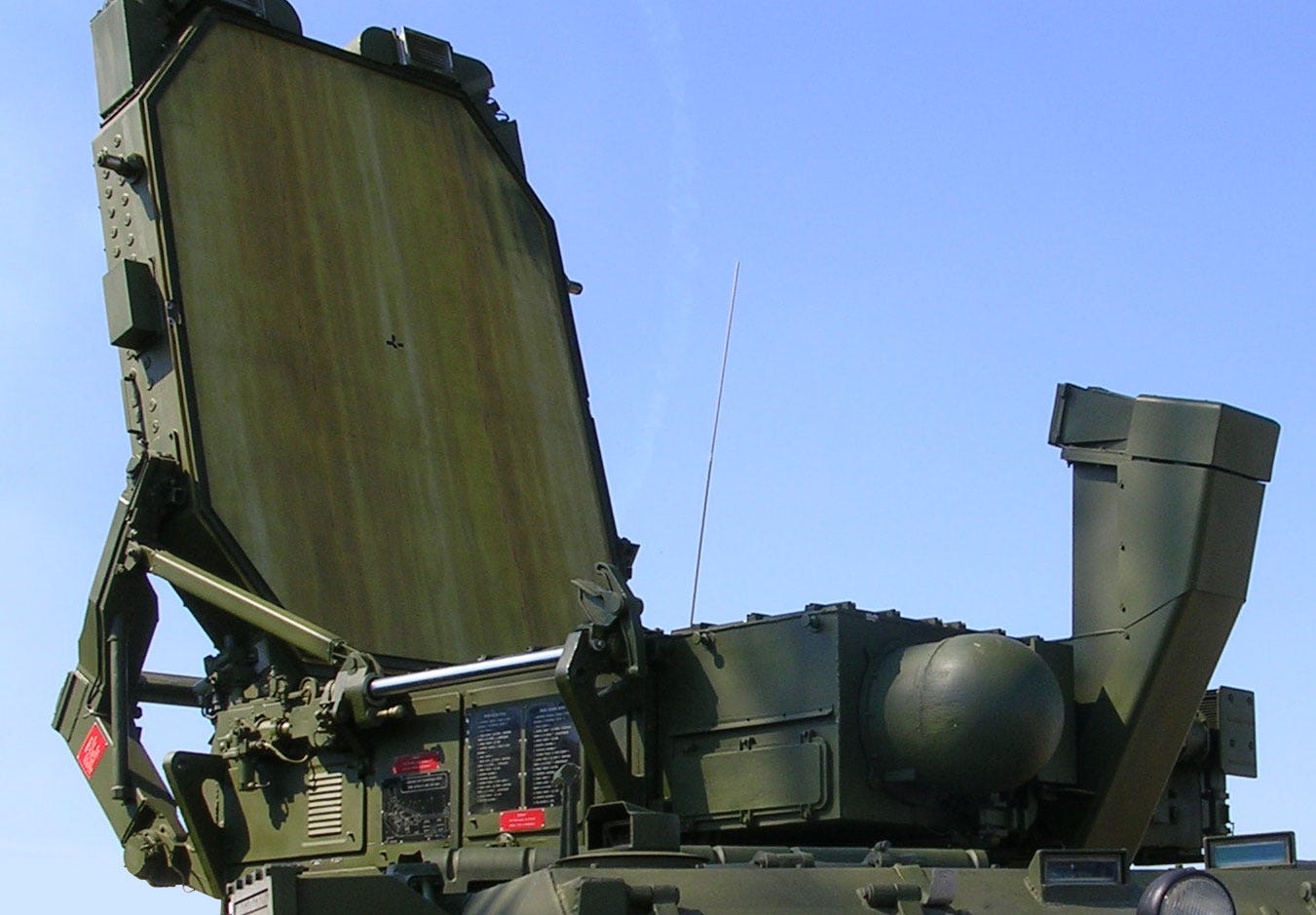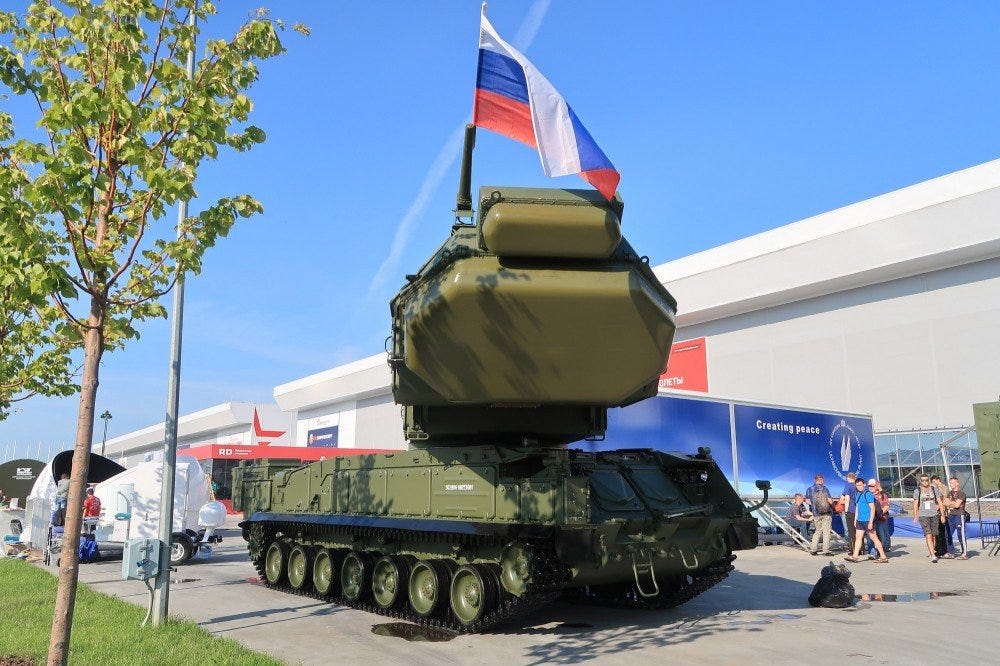Ukraine Snuffs Out Two More Expensive Russian Radars
Just a quick news flash - How do you eat an elephant? One small bite at a time...
News dropped earlier this week: Ukrainian FPV pilots have taken down not one, but two vital Russian radar systems. First, a 9S36M “Viking” radar, the eyes of a Buk‑M3 air-defense battery, got nailed mid-scan. Then, in a separate sortie, INTEL from UA_REG TEAM showed another FPV scoring a direct hit on a Zoopark‑1 artillery-locating radar, right when it was unfolding its dish for deployment.
Every small win is a step in the right direction.
Russia’s defenses, built like Swiss cheese when it comes to artillery positioning and air warnings, just had fresh holes punched in them. Ukraine essentially smashed advanced targeting systems while they were still booting up.
Let’s look at the brains behind Russian targeting strategies: the Zoopark and the Buk radar systems.
Zoopark‑1: The Ghost Hunter of Artillery
Imagine you're Russian artillery. You fire a shell and expect your target to dance into view. But Ukrainian counter-battery teams are patient, silent, waiting for radar signals bouncing off that shell arc. That’s where 1L219 Zoopark‑1 comes in: it’s the crown jewel of Russian counter-battery radars, developed by Almaz-Antey for the Soviet Armed Forces.
Operating in the UHF range, Zoopark sweeps the sky to detect incoming projectiles, triangulate splash points, and track their trajectories backward to origin. Before it arrived, Russia relied on outdated sound-locating gear and optical trackers.
Once the Russians got around to deploying Zoopark in year two of the invasion, it kind of changed the game for the invaders, allowing for rapid retaliation decisions in a kinetic, high-volume artillery war. Deploy one, let it fold out in about a minute, and suddenly your artillery units can ‘see’ enemy fire long before shells land.
But when that dish gets obliterated? Ground troops lose the ability to map incoming fire, target Ukrainian positions accurately, and adjust bombardments in real time. Ukraine just delivered that outcome at drone-level cost.
9S36M Viking: The Automated Watchtower for Buk-M3
On the flip side, the Buk‑M3 is a Russian mobile missile system meant to stomp NATO-style air attacks, from fighters to cruise missiles. It looks lumbering on the surface but is high tech underneath. The heart of this system is the 9S36M Viking radar, a 3D detection system capable of sniffing out threats at dozens of kilometers and handing them off to launchers.
When a Viking radar is knocked out, the Buk battery is essentially blind. No aerial threat assessment, no missile guidance. Ukraine's FPV swarmed in, circumventing layered defenses and dropping the radar before Buk crews could react. It’s not cheap; Buk-M3 sets are expensive at about $45 million, and just the radar by itself is $25 million. And Ukraine scored yet again with low-cost drone strikes.
Earlier, Ukraine’s 413th “Raid” Separate Unmanned Systems Battalion released video evidence showing the destruction of two advanced Russian radar systems, reportedly 1K148 “Yastreb-AV” units, with an estimated total value of $500 million.
Why Were These Radars Even in Drone Range?
You’d think, after two years of getting hammered by everything from Storm Shadows to garage-built quadcopters, Russian commanders might’ve learned a thing or two about camouflage, concealment, and, oh, I don’t know, not parking million-dollar radars within spitting distance of enemy drone teams. And yet, here we are again.
So why do they keep doing it?
Let’s unpack a few plausible theories, and yes, it’s a mix of hubris with a dash of desperation. And I’m just speculating:
Russia’s Radar-to-Frontline Addiction
First, a harsh battlefield truth: you can’t see what you can’t scan. In a drone-heavy artillery slugfest, counterbattery radars like Zoopark-1 need to operate close to the action. The further they’re pushed back, the lower the precision and the longer the reaction time for return fire. Russia isn't deploying these for funsies; they’re trying to keep artillery competitive.
Same goes for the Buk-M3’s 9S36M radar. You can’t just keep it parked 100 kilometers behind the lines like it’s a museum piece and still expect to track fast movers, drones, or HIMARS in real time. You need forward deployment. Which means exposure.
So one explanation is simple: they’re not being reckless, they’re being forced to take risks just to function.
Overconfidence in Electronic Warfare and Air Defenses
Russia built its doctrine on the assumption that electronic warfare (EW) supremacy would allow it to neutralize small drones before they could do damage. Spoiler: They have had mixed results.
Between Ukraine’s dynamic frequency-hopping drones, hardened flight controllers, and new AI-based autonomous navigation, FPVs are getting through. Russia’s aging EW stations, often based on Cold War-era tech repackaged in shiny chassis, just can’t keep up.
There’s also the assumption that air defense systems like Pantsir or Tor would intercept drones before impact. Except Pantsirs tend to prioritize big targets like helicopters, loitering munitions, and fixed-wing aircraft. A $2,000 drone coming in low and slow? It gets missed. A lot.
The result is a false sense of security, and a radar truck left wide open like it’s napping on the side of a highway.
Command Paralysis and Doctrine Lag
Despite everything they’ve suffered in 3+ years of war in Ukraine, Russia’s military command structure still favors centralized control over battlefield initiative. If a drone threat pops up and there’s no explicit order to relocate a radar unit, crews might not budge. This isn’t just poor discipline, it’s built-in doctrine. Units are often discouraged from relocating autonomously, even when under threat.
So, what you end up with is expensive hardware operating inside a kill zone, with zero battlefield mobility or decision-making flexibility. But what do you expect from a force that has no non-commissioned officers to execute the commander’s intent? It's a Soviet legacy in a modern war, and Ukraine’s decentralized drone forces are eating it alive.
Desperation Breeds Exposure
Let’s not rule out sheer desperation. Russia’s radar losses are piling up, 24 Zoopark variants and 11 9S36M radars gone, according to Oryx. At some point, you start running out of radars and have to use what's left, even if the deployment is less than ideal.
Need to spot HIMARS? You drag out the Zoopark and fire it up, never mind if there’s a Ukrainian drone team just over the tree line. It’s a gamble, but the alternative is going blind.
Logistics and Terrain Constraints
In some cases, Russia just doesn’t have the terrain advantage, camouflage netting, or secure staging areas to set up shop out of harm’s way. The occupied zones of Donetsk and Zaporizhzhia aren’t exactly radar-operator-friendly either. Hilly terrain, urban clutter, and Ukrainian ISR saturation make it hard to hide, hard to move, and harder still to survive.
So they roll the dice. Again and again.
If this feels familiar, it’s because Russia made the same mistake with tanks. They put T‑90s in exposed kill zones, thinking ERA bricks would save them. Then Javelins showed up. Now they’re doing the same thing with radars, trusting in doctrine and outdated defenses to save tech that’s just too visible, too expensive, and too vital.

At this rate, Ukraine is systematically dismantling the backbone of Russian situational awareness.
And the message is clear: in modern warfare, if your million-dollar radar can’t move fast, hide well, or think for itself, some 22-year-old with a PlayStation controller and a drone kit from Alibaba will find it and turn it into a smoking crater.
Adapt, or get drone-sniped trying.
With cheap drones, Ukraine is slicing off the enemy’s eyes and ears. The result is a silent battlefield. Russian artillery units can’t fire accurately, their air defenses can’t see incoming versus outgoing threats, and command posts scramble to manage without eyes in the sky.
There’s also a morale component. Watching one of your most advanced radar systems get slammed by a $500 FPV drone in real time does more than eliminate Soviet equipment; it eats away at confidence. And let’s not forget the economics: a cheap drone disabling a multimillion-dollar asset is the kind of asymmetric math Ukraine thrives on. This is all about eroding the technological backbone of Russia’s war machine, one antenna array at a time.
So, what does Russia do next? Try to adapt fast. Expect to see mobile radar systems shift to tracked chassis, giving them better chances of redeployment before Ukraine’s drones can sniff them out. Gone are the days of static radar parks. In their place? Stealthier, mobile pods hiding in the folds of the terrain like nervous game pieces.
They’ll also start stacking tech: layering drone detection suites into radar vehicles themselves, creating a "radar-in-radar" setup, essentially nesting doll defense. And because no one likes watching millions of rubles explode on Telegram, we’ll likely see hardened radar enclosures too, think armor plating, angled steel, or buried launch modules.
Meanwhile, Russia’s electronic warfare teams will get busier, jamming FPV drone frequencies and forcing Ukraine to invest in more sophisticated (read: expensive) workarounds. It’s “escalation by microchip”.
Will it be enough? Maybe. But each defensive upgrade raises complexity, weight, cost, and often still falls short of blocking hundreds of $5,000 drones.
The 14th Separate UAV Regiment and UA_REG TEAM are really good at what they do. They’re not relying on blind fire, overwhelming missile salvos, or air footprints. They’re going digital, conducting multi-kilometer reconnaissance via signal intercepts, adapting in real time, and striking accordingly.
Ukrainian drone pilots just clipped the legs off a giant, not with bombs, but with finesse. They’ve proven that in the digital age, overwhelming isn’t always winning; precision is.
Take two radars, render them useless, and now Russia has a blindfolded artillery unit and air defense crews scrambling in the dark in a hot zone. That’s a blueprint for modern, asymmetric warfare.
And if Ukraine can keep this stride, chip away at radars, logistics chains, layered defenses, those ‘giant’ systems get smaller every day. So, while drones and missiles and more drones keep dominating headlines, out in the dust, Ukraine’s FPV pilots are quietly erasing them from the board.
That’s where the smart war is being won today, courtesy of drones, determination, and a dash of street-level ingenuity.
Okay, that’s it for this quick Tuesday update. Stay frosty.
Слава Україні!




I've been telling people that Ukraine has created and led the biggest revolution in warfare since stealth aircraft and maybe even the aircraft carrier.
One thing that surprises me - and perhaps it is just news media not keeping up - is that Ukraine seems to have been slow to adopt the obvious strategy of targeting Russia's logistical rail network. We are only now seeing them target trains, rail bridges and signal systems, which is perfectly logical considering Russians rely heavily on them for military supply. Take Kursk for example. As Ukraine withdrew from there I would have thought that they would destroy every rail bridge in the occupied area that feeds the Eastern front further south. Then there is the Kerch Bridge: they may not be able to destroy that yet, but they can surely and repeatedly disrupt rail access over it.